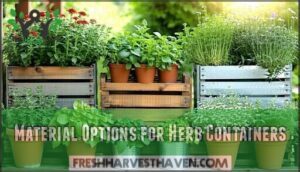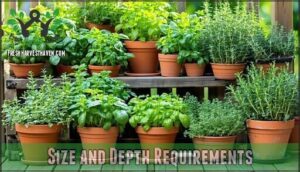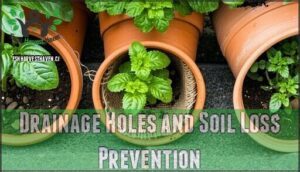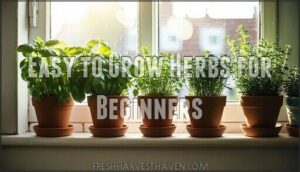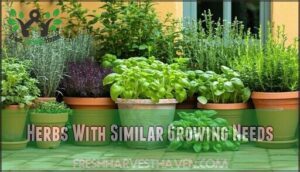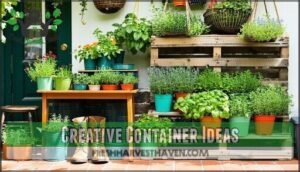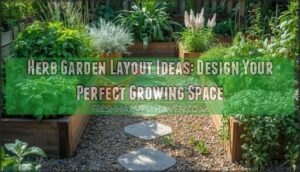This site is supported by our readers. We may earn a commission, at no cost to you, if you purchase through links.
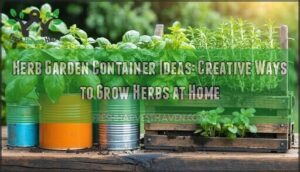
For a modern touch, try vertical gardens with hanging baskets or wall-mounted pots. Want something rustic? Repurpose an old toolbox or wine crate.
Herbs like basil and parsley thrive in shallow containers, while rosemary prefers deeper ones. Group herbs with similar water needs to simplify care.
Remember, good soil and proper drainage are key. Ready to get creative? These ideas are just the tip of the iceberg for growing herbs at home!
Table Of Contents
- Key Takeaways
- Choosing Containers
- Herb Selection Basics
- Container Gardening Tips
- Creative Container Ideas
- Herb Care and Maintenance
- Frequently Asked Questions (FAQs)
- What is the best container for herbs?
- What herbs go well together in a container?
- What herbs can you grow in a container garden?
- How to choose herbs for your container garden?
- Can you grow herbs in a container?
- Can you grow herbs in pots?
- How do I prevent pests in herb containers?
- Can herbs grow in low-light indoor spaces?
- What are the best herbs for small spaces?
- How do I fertilize container-grown herbs?
- Conclusion
Key Takeaways
- Use what you’ve got—repurpose items like mugs, tin cans, or wooden crates as planters, but make sure they have drainage holes.
- Group herbs with similar water and sunlight needs, like rosemary and thyme for dry soil or basil and cilantro for moist conditions.
- Choose containers based on herb size; shallow pots work for basil, while rosemary needs deeper ones for healthy growth.
- Regularly prune and harvest to encourage growth, and check for pests or diseases to keep your herbs healthy.
Choosing Containers
Choosing the right containers is essential to keep your herbs healthy and thriving. Focus on selecting materials, sizes, and drainage options that meet your plants’ specific needs.
Material Options for Herb Containers
Choosing the right materials for herb containers makes all the difference.
Cedar offers durability and resists rot, while galvanized steel containers add a sleek, modern touch.
Cedar resists rot with natural durability, while galvanized steel adds a sleek, modern vibe to your herb garden.
Terra cotta clay is a classic, providing quick drainage with its natural materials.
Consider various container types for superior growth.
Look for “food grade” and “untreated” labels to guarantee safe, eco-friendly choices, and balance function and style seamlessly.
Size and Depth Requirements
A successful herb container garden depends on choosing the right pot dimensions. Herbs vary in root systems and growth habits, so match plant size to container depth.
For container herb gardening, consider the following guidelines:
- Small herbs need 6 inches of root space.
- Larger herbs prefer 12 inches.
- Use shallow roots for compact spaces.
- Prioritize container volume for healthy growth.
- Check herb size before planting.
Consider optimal potting mix to guarantee proper drainage and nutrient availability, which is crucial for a healthy growth and can be found at optimal potting mix, ensuring the best results for your herb container garden with proper drainage and nutrient availability.
Drainage Holes and Soil Loss Prevention
After picking the right container size, focus on drainage. Drainage holes should be spaced 3-4 inches apart for proper water flow.
Prevent soil loss by adding weed barrier cloth or burlap at the bottom.
Container material impacts drainage too—terra cotta dries quickly, while steel retains moisture. For containers without holes, use small rocks as an alternative drainage method.
Herb Selection Basics
Choosing the right herbs for your container garden is key to success, especially if you’re just starting out.
Focus on easy-to-grow options like basil and parsley, and group herbs with similar water and sunlight needs for healthier growth.
Easy to Grow Herbs for Beginners
Why not start with beginner herb choices like basil, parsley, or chives? These easy herb garden staples thrive in containers, needing just sunlight and regular watering.
Avoid common beginner mistakes like overwatering or placing them in low light. Harvesting techniques are simple—snip leaves often to encourage growth.
Container gardening herbs make herb care effortless, even for beginners. Make certain your containers have drainage to prevent potential root rot.
Herbs With Similar Growing Needs
Grouping herbs with similar growing needs streamlines your herb garden planning and boosts growth.
Match herbs by sunlight needs, soil preferences, and watering frequency for a thriving herb container garden.
Here’s a quick guide:
- Rosemary and thyme: dry soil lovers.
- Basil and cilantro: moist soil buddies.
- Mint: thrives solo, damp soil.
- Parsley: partial sun, consistent moisture.
- Sage: nutrient-rich, well-drained soil.
This guide helps you create a thriving garden by considering the specific needs of each herb, allowing for a more efficient and streamlined approach to gardening.
Separating Annual and Perennial Herbs
Understanding lifespan differences helps when separating annual herbs like basil from perennials such as rosemary.
Annuals focus on quick growth and seasonal planting, while perennials offer regrowth habits year after year.
Their root systems differ too—annuals need less depth, while perennials thrive in deeper containers.
For creative herb garden ideas, try mixing them in herb garden combinations or use propagation methods to expand, and consider the benefits of perennials.
Container Gardening Tips
To grow healthy herbs in containers, you’ll need the right soil, proper drainage, and a consistent watering routine.
Grouping herbs with similar water needs can make care easier and guarantee they thrive together.
Soil and Drainage Recommendations
Good soil composition is key for thriving herbs.
Mix topsoil, compost, and sand for drainage solutions that prevent soggy roots.
Verify containers are at least 6 inches deep with proper drainage holes.
Add nutrient amendments like earthworm castings for growth.
Check pH balance; most herbs prefer slightly acidic soil.
A layer of small rocks can help improve drainage further.
For ideal growth, consider using well-draining soil mixes to achieve optimal results.
Watering and Hydration Requirements
Keeping herbs happy means staying on top of watering and soil moisture. Overwatering can harm roots, so aim for balance.
Test moisture with your finger—if soil feels dry an inch down, water gently.
- Use pots with proper drainage to prevent soggy roots.
- Adjust watering frequency for each herb.
- Self-watering containers can simplify moisture regulation, especially for beginners.
Many gardeners find herb watering solutions particularly helpful, using self-watering containers to make the process easier.
Grouping Herbs by Water Needs
When watering your herb garden, group plants by water preferences to simplify care.
Dry soil herbs like rosemary and thyme thrive together, while moist soil herbs such as basil and cilantro pair well.
Adjust watering frequency based on their needs to maintain proper soil moisture levels.
Companion planting in your herb container garden enhances growth and keeps maintenance stress-free, promoting a healthy and thriving environment through proper care.
Creative Container Ideas
You can grow herbs in creative containers that fit your space and style while using everyday items you already have.
Repurposed planters, vertical gardens, and hanging baskets are functional choices that make your herb garden stand out, using creative containers.
Repurposed Planters and Upcycled Materials
Think outside the pot! Vintage containers like teacups or old toolboxes add charm to your herb garden.
Vintage teacups or old toolboxes bring unique charm and creativity to your herb garden.
Creative upcycling turns rain boots or metal watering cans into unique DIY planters. For material sustainability, repurpose logs or bricks as durable options.
Portable gardens thrive in movable items like wheelbarrows, letting you rearrange with ease. These container garden ideas make herbs fun and functional, and bring a touch of charm to your space!
Hanging Baskets and Vertical Gardens
Hanging baskets and vertical herb gardens are perfect for small spaces like balconies.
They save space, add aesthetic appeal, and make herbs easily accessible.
Choose trailing herbs like oregano or mint for cascading effects.
For DIY projects, repurpose items like shoe organizers or trellises.
Consider using specially designed products for best results.
Maintenance tips include ensuring proper drainage and regular watering.
These container garden ideas elevate any herb garden!
Wooden and Metal Container Options
Wooden and metal containers offer durability and style for your herb garden.
Cedar planters resist rot, while untreated wood guarantees safety for herbs.
Steel pots bring sleek aesthetics but watch for container rust over time.
Avoid metal toxicity by choosing food-safe options.
These versatile herb garden container ideas blend function and charm, making your planters both practical and visually appealing.
Herb Care and Maintenance
Taking care of your herb garden guarantees healthy, flavorful plants all season long. With regular pruning, proper watering, and pest protection, your herbs will thrive in their containers.
Regular Harvesting and Pruning Techniques
Regular harvesting and pruning keep your herb garden thriving. Use sharp scissors or pruners for clean cuts.
Follow these herb harvesting tips:
- Harvest frequently to promote growth and enhance flavor.
- Prune herbs like basil by pinching above leaf pairs.
- Remove flower buds to prevent bitterness.
- Trim mint and parsley regularly for bushier plants.
Happy snipping!
Protecting Herbs From Pests and Diseases
After pruning, stay vigilant with pest prevention. Inspect leaves for pests like aphids or spider mites using a magnifying glass.
Companion planting can naturally repel pests; thyme deters mosquitoes, while rosemary protects nearby plants.
For disease prevention, clear debris and use organic solutions like neem oil. Proper watering can also help, as well-drained soil prevents root rot.
A clean herb garden guarantees healthier plants and keeps container gardening stress-free.
Overwintering and Refreshing Containers
Preparing your herb garden for winter guarantees healthy growth next season.
Follow these steps for effective overwintering and a fresh start:
- Indoor relocation: Move tender herbs indoors to avoid frost damage.
- Dormancy strategies: Reduce watering and let hardy herbs rest.
- Pruning before: Trim dead or weak growth for better regrowth.
- Compost refresh: Add nutrient-rich compost to containers.
- Container cleaning: Wash pots to prevent pests and diseases.
Frequently Asked Questions (FAQs)
What is the best container for herbs?
Imagine your herbs as travelers needing cozy homes.
Terra cotta pots work best, offering excellent drainage and breathability.
Choose containers at least 6 inches deep with drainage holes, and pair with well-draining soil for happy roots.
What herbs go well together in a container?
Group herbs with similar needs: rosemary, thyme, and sage thrive in dry soil, while basil, parsley, and cilantro prefer moist conditions.
Keep mint alone—it’s invasive.
Pairing wisely guarantees happy plants and easier care!
What herbs can you grow in a container garden?
Growing herbs in containers is like having a mini chef’s garden at your fingertips.
Try basil, mint, rosemary, thyme, parsley, or cilantro.
They thrive in pots, need minimal care, and keep your cooking fresh!
How to choose herbs for your container garden?
Pick herbs you’ll actually use—basil for pasta, mint for tea, or rosemary for roasts.
Match their needs to your space: sun-lovers like thyme thrive outdoors, while parsley prefers partial shade.
Keep it practical!
Can you grow herbs in a container?
Herbs are container-friendly champs, thriving in tight spots like patios or windowsills.
Just grab a pot with good drainage, use nutrient-rich soil, and water smartly.
You’ll have fresh flavors at your fingertips!
Can you grow herbs in pots?
Yes, you can grow herbs in pots.
They’re perfect for small spaces, easy to move, and require minimal upkeep.
Just make certain of good drainage, proper soil, and sunlight, and you’ll enjoy fresh herbs year-round.
How do I prevent pests in herb containers?
Keep pests away by inspecting plants regularly, removing debris, and using natural repellents like neem oil or garlic spray.
Elevate containers to deter crawling insects, and companion plant pest-repellent herbs like lavender or rosemary nearby.
Can herbs grow in low-light indoor spaces?
Around 30% of herbs can thrive in low-light spaces, like mint, parsley, and chives.
Place them near north-facing windows or use grow lights.
Keep soil moist, but don’t overwater, to avoid root rot.
What are the best herbs for small spaces?
For small spaces, go for compact herbs like basil, chives, thyme, or parsley.
They thrive in small pots, need minimal care, and provide fresh flavors.
Mint works too—just keep it in its own container to prevent overgrowth.
How do I fertilize container-grown herbs?
Ever wonder how to keep your herbs thriving?
Use a balanced liquid fertilizer every 4-6 weeks, diluting it to half strength.
Avoid overfeeding—herbs prefer lean soil, and too much fertilizer can dull their flavor.
Conclusion
Picture a windowsill lined with tin cans bursting with basil and parsley—practical, charming, and easy to manage.
With the right containers, good soil, and proper drainage, you’re set to grow thriving herbs at home.
Group plants with similar water needs, and don’t forget to prune regularly for healthy growth.
From repurposed crates to vertical gardens, these herb garden container ideas let you get creative while keeping things functional.
Start small, and watch your herb garden flourish!
- https://www.marthastewart.com/8369699/herb-garden-ideas
- https://www.goodhousekeeping.com/home/gardening/g64176458/herb-garden-ideas/
- https://www.hgtv.com/outdoors/flowers-and-plants/herbs/herb-garden-design-ideas-pictures
- https://www.gardenary.com/blog/how-to-grow-herbs-in-a-small-space
- https://bungalow47.com/a-creative-container-herb-garden/

